- HOME
- reviews
- interviews
- Michael Urie
- Bruce R. Coleman
- Val Kilmer
- Addison Reid Coe
- MaryJoanna Grisso
- Constantine Maroulis
- Sarah Gettelfinger
- Douglas Sills
- George Hamilton
- Christopher Sieber
- Lea Salonga
- Brian Stokes Mitchell
- Terrance Mann
- Stephen Cook
- Anthony Rapp
- Chita Rivera
- Rent Interview
- Lisa Rinna - Chicago
- Liza Lerner
- Wonderful Town
- Paige Davis
- Michael Urie
- Wilson Cruz
- Christian Campbell
- Craig Bierko
- Jarrod Emick
- articles
- 2017 DSM Gala Patron Party
- Broadway's Leading Ladies
- ATTENTION Dallas/Fort Worth Theatre Community!
- GTC Announces 2018 Season
- Support Bedford ONSTAGE
- Upstart Productions embarks on a multi-city major market tour
- Dallas Theater Center to Receive 2017 Regional Theatre Tony Award
- Kenneth T. Novice Named Dallas Summer Musicals President
- Lyric Stage Celebrates 25th Anniversary Season
- Kenneth T. Novice Named Dallas Summer Musicals President
- DSM announces 2017-2018 Season Lineup
- Bernadette Peters is entertainment for DSM 2017 Gala
- Benefit concert for Derek Whitener
- Local students win awards at JTF 2017
- Best of 2016
- Jeffrey Schmidt named Artistic Director at Theatre Three
- Interview: Lyle Huchton, Costume Designer
- DSM and BAA announce a new partnership
- Rose Pearson of Circle Theatre Passes Away
- Dallas Summer Musicals Names Three as “Managing Director Emeritus”
- The 5th Annual Dallas Summer Musicals High School Musical Theatre Awards Make History
- DSM announces 2016-2017 Season Lineup
- WaterTower Theatre Announces its 2016-2017 20th Anniversary Season
- DFW Theatre Community mourns the loss of local actress
- Letter from Buff Shurr
- WaterTower Theatre Names Kelsey Leigh Ervi as Associate Artistic Director
- 2016 Tony Award Nominations
- Dallas Summer Musicals to Chart New Course
- DSM High School Musical Theatre Awards
- The AT&T Performing Arts Center Announces 2016/2017 Broadway Series Season
- Theatre Three Announces 2016-2017 season
- Column Award Winner & Casa Kid on Broadway
- Shaping Sound at Bass Hall for One Night Only
- Best of 2015
- A Celebration of the Life of Jac Adler
- MATILDA THE MUSICAL makes its Dallas Premiere
- The Broadway League Presents Two Awards to Dallas Summer Musicals
- DCT accepting FANCY NANCY costume contest entries
- IF/THEN national tour comes to Winspear Opera House
- DALLAS SUMMER MUSICALS announces 2015-2016 season
- TONY AWARD WINNER BETH LEAVEL TO CO-HOST 17th ANNUAL COLUMN AWARDS
- Statement of the Board of Directors on the death of Jac Alder
- Column Awards Donates $6,500 to BCEFA
- 2015 Tony Nominations
- Terry Dobson
- Runway Theatre’s 2015-2016 Season
- Nominees for the 4th Annual Dallas Summer Musicals High School Musical Theatre Awards
- The AT&T Performing Arts Center Announces 2015/2016 Broadway Series Season
- DALLAS THEATER CENTER announces 2015-2016 season
- Lillias White Masterclass 2014
- Michael A. Jenkins named 2014 Newsmaker of the Year
- Plano's Courtyard Theater seeking new resident theater company
- DFW area member of the theatre community, Wendy Lee Tedmon passes away
- VIP Opening night reception with Michael Urie
- Plaza Theatre Company announces 2015 Season
- Uptown Players announces 2015 Season Lineup
- Behind the scenes - Xanadu
- casting news
- Rockwall Community Playhouse announces casting and creative team for FORUM
- Theatre of North Texas announces casting and creative team for One Flew Over the Cuckoo's Nest
- Rover Dramawerks announces casting and creative team for 18 Holes
- CINDERELLA announces casting for the first national tour
- Tarrant Actors Regional Theatre presents the cast and crew for THE CRUCIBLE
- AT&T Performing Arts Center announces casting and creative team for THE PHANTOM OF THE OPERA
- Garland Civic Theatre announces the cast and creative team for THE WIZ
- Rockwall Summer Musicals announces the cast and creative team for ANYTHING GOES
- Sherman Community Players announces casting and creative team for CHICAGO
- Garland Summer Musicals announces casting and creative team for PETER PAN
- Rover Dramawerks announces casting and creative team for WRENS
- Greater Lewisville Community Theatre announces cast for BOEING, BOEING
- Uptown Players presents the cast for THE LYONS
- Tarrant Actors Regional Theatre presents the cast and crew for THE CURIOUS SAVAGE
- Runway Theatre announces casting for OVER THE RIVER AND THROUGH THE WOODS
- Runway Theatre announces casting and creative team for CHRISTMAS BELLES
- Theatre Three announces casting and creative team for ON THE EVE
- Lakeside Community Theatre announces casting and creative team for A CHRISTMAS STORY
- Plaza Theatre Company announces casting and creative team for WHITE CHRISTMAS
- Rover Dramawerks announces casting and creative team for BLOODY MURDER
- ICT MainStage announces casting and creative for OUR TOWN
- Casting announcement for the world premiere of the new musical BROKEN
- Sherman Community Players announces casting and creative team for FRANKENSTEIN 1930
- Runway Theatre announces casting and creative team for CLUE THE MUSICAL
- Pfamily Arts Theatre announces casting and creative team for DROOD-THE MYSTERY OF EDWIN DROOD
- Rover Dramawerks announces casting for IT RUNS IN THE FAMILY
- Camp Death Productions announces casting for SPRING-HEELED JACK VS. THE ENIGMATIC DR. HU
- GLCT announces cast and creative for SPAMALOT
- Tarrant Actors Regional Theatre announces cast for THE WOMAN IN BLACK
- Plaza Theatre Company announces cast for MAN OF LA MANCHA
- ICT MainStage announces cast for BELLS ARE RINGING
- WaterTower Theatre announces cast for XANADU
- Runway Theatre announces cast for A STREETCAR NAMED DESIRE
- Rover Dramawerks announces cast for THE REMARKABLE MR. PENNYPACKER
- OnStage Players announces cast for PROOF
- The Firehouse Theatre announces cast for ROMEO AND JULIET
- Uptown Players announces cast for KISS OF THE SPIDERWOMAN
- McKinney Summer Musicals announces cast for FIDDLER ON THE ROOF
- Plaza Theatre Company announces cast for DIRTY ROTTEN SCOUNDRELS
- Music Theatre Denton announces cast for ALL SHOOK UP
- Artes de la Rosa announces cast for IN THE HEIGHTS
- Uptown Players announces cast for SONGS OF A NEW WORLD
- The Column Awards Organization announces cast for LA CAGE AUX COLUMN
- about us
- theatre links
- contact us
OUT OF THE LOOP FRINGE FESTIVAL
FIRST WEEKEND
PART TWO
Sidewalk Stories, Honky, Butcher Holler Here We Come,
An Evening with DNCB, Playing with Myself, and Sweet Chariot
Other festival reviews:
First Weekend, Part One
OUT OF THE LOOP FRINGE FESTIVAL – FIRST WEEKEND, PART TWO
(Sidewalk Stories, Honky, Butcher Holler Here We Come, An Evening with DNCB, Playing with Myself, and Sweet Chariot)
WaterTower Theatre
A 10‐day celebration of theatre, dance, music, and art, the Out of the Loop Fringe Festival features performances by arts organizations and artists from across the nation. Performances are held at the Addison Theatre Centre, in four performance venues.
Eighteen artists and performing arts organizations will participate in this year’s festival of which twelve are making their debut. Seven world premieres will be presented at this year’s festival.
On the final day of the festival, WaterTower Theatre will invite back the Best of the Main Stage, Studio Theatre and Stone Cottage performers for a special performance, as chosen by our Loop passholders. Passholders will have an opportunity to cast ballots for their “Best Of” choice on the final Saturday of the festival.
Festival Passes are $65.00 and include one admission to each Festival event. WaterTower Theatre subscribers receive $10.00 off each Festival pass.
Individual ticket prices for each event are $10.00 or $15.00.
_____________________________________________________________________
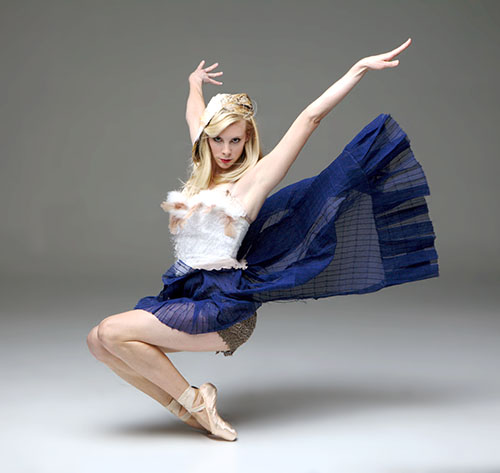 1. SIDEWALK STORIES
1. SIDEWALK STORIES
Contemporary Ballet Dallas
Choreographed by Jennifer Obeney, Jennifer Arellano, Erin Mallar Boone, Valerie Shelton Tabor, Lindsay Bowman, Danielle Georgiou, and Lea Essmyer
DANCERS
Stephen Raikes, Lisa Stoller, Amanda Will, Jennifer Obeney, Jaclyn Brewer Poole, Paula Ulery-Reynolds, Courtney Beacham, Erin Boone, Lea Essmyer, Colleen Pagnotta, Addison Reed, Brandon McGee, Whitney Hart, Rachel Meador, Koreyci Barreto, Haylee Barganier, and Emillie Skinner
Reviewed performance on Saturday, March 8th, 2014
Reviewed by Joel David Taylor, Associate Theater Critic
for John Garcia’s THE COLUMN
Sidewalk Stories uses modern and ballet dance to present different perspectives on a variety of urban experiences. Each scene has unique choreography; costuming, lighting design, and music that assist the dancers bring the audience into the scene. Some of the dances use more props, while others have lighting designs to project shadows on the screen upstage for a shadowy effect, or a flowing pattern of light on the floor to portray moving water.
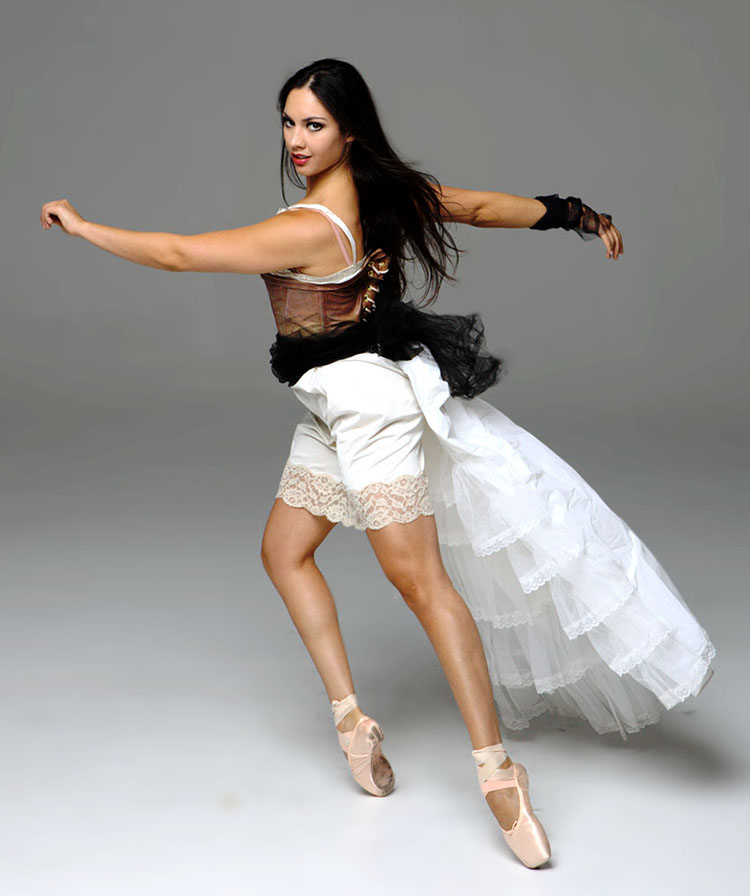 The performance opens with Round of Regulars, a dance set in a sidewalk café. Two male and female couples sit at small tables set together, having a beer. Another couple is seated at a table down left, while the table down right has one lone occupant, draped over the table as if she’s had too much to drink. The four female dancers alternately rise and dance to present happiness at finding love, anguish and anger at missing someone or being out on a bad date. While their movement is fluid and brought me into the story, there are a few things that create a disconnection from the story and are distracting. The couples sitting in the back are interacting and conversing with each other, but it is not consistent, engaging or adds to the dance. There are unopened beer bottles on the tables, but only one dancer actually opens and drinks from the bottle, while the rest pretend to drink from theirs.
The performance opens with Round of Regulars, a dance set in a sidewalk café. Two male and female couples sit at small tables set together, having a beer. Another couple is seated at a table down left, while the table down right has one lone occupant, draped over the table as if she’s had too much to drink. The four female dancers alternately rise and dance to present happiness at finding love, anguish and anger at missing someone or being out on a bad date. While their movement is fluid and brought me into the story, there are a few things that create a disconnection from the story and are distracting. The couples sitting in the back are interacting and conversing with each other, but it is not consistent, engaging or adds to the dance. There are unopened beer bottles on the tables, but only one dancer actually opens and drinks from the bottle, while the rest pretend to drink from theirs.
Each of the subsequent dances, “Tango, Tango”, “The Last Dream”, “Sunday in the Park”, “Come Back To Me”, “Souvenir” and “The Lyra”, rely less on props and more on the music and dance movements, with an occasional lighting enhancement to present the passion and story.
Many of the dancers are expressive through only their movements, keeping their faces almost emotionless. It is primarily the younger dancers who express more of the passion of the dance through their eyes and face, which creates a much bigger emotional impact and connection.
The dancing in all seven numbers is superb. The fluid ways the dancers interact with each other, telling the story with subtle movements of the head or arm, a leap or fall, cannot be fully appreciated with only my words. Sidewalk Stories shows that skilled dancing artistry can also present stories that pull you in, even without spoken dialogue.
Reviewed by Joel David Taylor, Associate Theater Critic
for John Garcia’s THE COLUMN
SIDEWALK STORIES
Contemporary Ballet Dallas
Final performances on Wednesday, March 12th at 7:30 pm, and Saturday, March 15th at 2:00 pm
_____________________________________________________________________
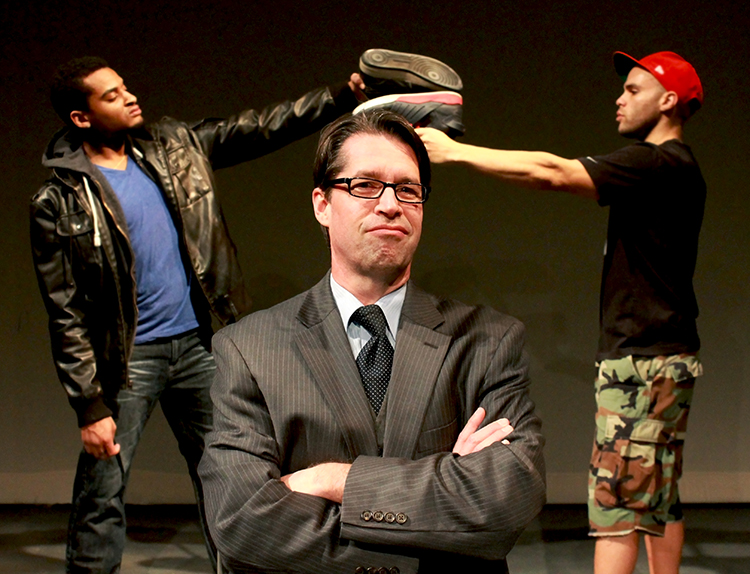 2. HONKY
2. HONKY
Written by Greg Kalleres
WaterTower Theatre
Directed by Kelsey Leigh Ervi
Assistant Director – DR Mann Hanson
Lighting Design – Ryan Flores
Sound Design – Kellen Voss
Video Design – Casey Barteau, Adam Henderson, and Kellen Voss
Stage Manager – Kristin Van Sickle
CAST
Calvin Roberts – Thomas Hodge
Alan Pollard – Davis Tallison
Ian Ferguson – Peter Trammel
Rebecca McDonald – Emilia Hodge
Whitney Holotik – Andie Chastain
Jeff Burleson – Dr. Driscoll/Others
Adam A. Anderson – Kid 1/Frederick Douglas
Lord Alfred Brown – Kid 2
Reviewed performance on Saturday, March 8th, 2014
Reviewed by Mary L Clark, Associate Theater Critic
for John Garcia’s THE COLUMN
The title alone makes anyone who utters it a racist, and is offense to white people - or should I say Caucasian. Black people, uh, African-Americans, use it and “their people” claim we’re racist when “our people” say n**ger!
If any of that makes you the least bit uncomfortable, well then, welcome to playwright Greg Kalleres’ mind and his play, Honky, WaterTower Theatre’s enlightening festival entry. No racial epithet goes unturned as Kalleres hits every un-politically correct word, phrase or racial remark there is, and hits them hard. His characters think and say everything each of us either recognizes, has thought, felt or said. The words are now so commonplace as to no longer hold any power. The Late Show’s Craig Ferguson calls his producer racist practically every night !
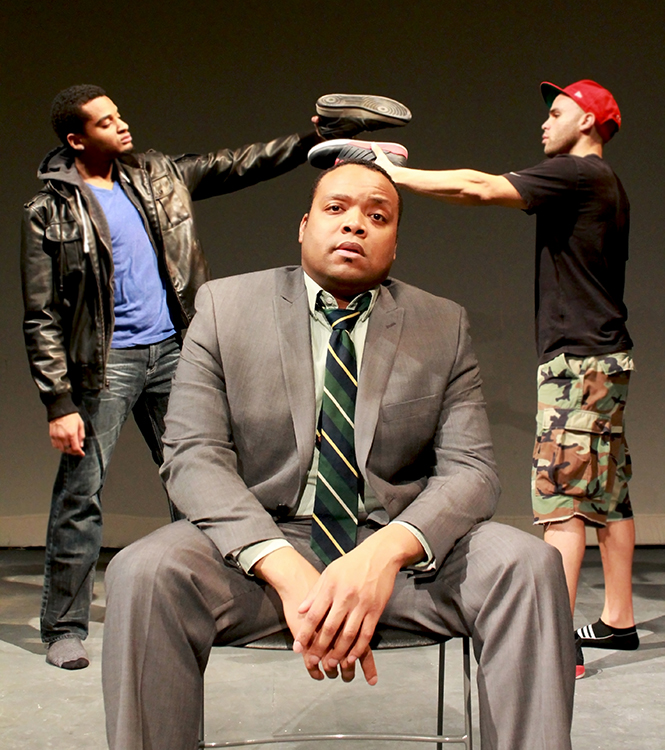 This dark comedy centers around an all-too-often advertising focus, that purchasing the newest item, the hottest thing will make you special and happy. A basketball shoe commercial glorifies gang violence in order to sell them to white teens. But then a black teenager is shot and killed for the same shoes. Who’s to blame, the commercial or the CEO that ok’d it to triple sales? And what about the shoe designer, the advertising writer, or parents who give in to media mass appeal?
This dark comedy centers around an all-too-often advertising focus, that purchasing the newest item, the hottest thing will make you special and happy. A basketball shoe commercial glorifies gang violence in order to sell them to white teens. But then a black teenager is shot and killed for the same shoes. Who’s to blame, the commercial or the CEO that ok’d it to triple sales? And what about the shoe designer, the advertising writer, or parents who give in to media mass appeal?
The playwright also lampoons our obsession with psychoanalysis, the pharmaceutical world and America’s addiction for the next “perfect pill”, with the slogan, “If you don’t think you need it, you’re probably a racist!”
Director Kelsey Leigh Ervi keeps the pace lively and the many scene changes quick, using multi-use, roll-on furniture to accent seven different locations, including the CEO’s office, a psychiatrist’s office, two bedrooms, and the subway. The opening video ad shows two basketball players one-upping each other on the court, until one whips out his new “Sky Max” shoe like a gun. Back wall projections that only show the outside of the office buildings or brownstones make the locations sterile and distant, an interesting concept.
Kalleres uses heightened-reality dialogue to strike every racist stereotype: the highly racist, white and white-collared corporate man; the black artist “selling out to the man” with his designs; the overly sensitive and apologetic white man who struggles to be PC while offending just about everyone. There’s the side cap wearing, pants low-hanging “gangsta boys” we assume to be criminals by the way they look; the black, well-dressed men who rob the white man on the subway; and a professional black woman who cannot get past her hatred of whites in order to help her patients. Finally, there is the young, white woman who has absolutely no filter when it comes to speaking the truth about racism, and that everyone, everywhere, has some of it in them. Her words and observations are refreshing, unrealistic but refreshing to hear, especially onstage.
The eight actors in Honky take on these characters no holds barred. In order of appearance, Calvin Roberts is Thomas Hodge, the shoe designer desiring notoriety, and the money, but conflicted about the boy’s death, and that he is becoming an Uncle Tom to the every company that might have instigated it. Roberts plays both sides very well, inner turmoil showing on his face and in his voice, as the black man “his people” call “whitey”, and his hatred for “the man”, this time played by Alan Pollard.
Pollard is Davis Tallison, the slimeball CEO that fairly drips bigotry and racism. His facial expressions while scheming a new deal with Roberts is priceless. When Tallison tries to conform via an anti-racist drug, Pollard takes Tallison to the other extreme, first as a believable drunkard, then as a crazed and enthusiastic corporate pill pusher.
Writer of the damning commercial, guilt-ridden Peter Trammel finds himself on the psychiatrist’s couch. Ian Ferguson’s comedic portrayal of this white man’s angst and continual “racial” blunderings is marvelous. His fast-paced dialogue, fumbling and tumbling over his sentences, is an astounding display of memorized lines! Amongst all his apologies to his black, woman psychiatrist is the great, “I could be a racist! You see, that’s what makes America great. We can be anything we want . . . “ !
Emilia Hodge, Thomas’ sister, is an uptight, doctor with little patience for the white people who seek her knowledge. As Emilia, Rebecca McDonald’s face barely controls her rage toward listening to yet one more pathetic white person. I hope I’m right when I say her character has one of the central theme lines of the play, “Let’s leave the Race word out of it . . . it’s their word, we can’t say it”. McDonald keeps Emilia under such control it is a shock to see her suddenly straddle Trammel in one of the last scenes, a shockingly funny image to be sure!
Whitney Holotik plays the truth-spewing woman, and fiancée to Trammel, Andie Chastain. Her easy-going demeanor is totally opposite the others; Chastain cuts through all the PC and racist bull, and Holotik does a magnificent job playing her lightly, rather than as a lecturer. Another great line is hers, when Trammel moans we should be concerned with all the pain and suffering in the world, she retorts, “Just because you went to public school, you’re not Nelson Mandela” – perfect. I really like her scenes with Calvin as she takes the piss out of him each time he tries to play the R card. If only we dared that more often . . . .
Jeff Burleson is literally the “Everyman” of the play, being the nerdy corporate employee attempting to warn Tallison that his racism is too extreme. He then comes back as Dr. Driscoll, the pill man with claims to end racism, and a TV reporter. His best role is Abe Lincoln as hallucination, appearing to Emilia after she takes the magic pill in order to erase “hatred, anger, righteous, and indignation”. Burleson’s Lincoln is a hoot, using a higher-pitched voice (as did Daniel Day Lewis) while spewing urban, slang phrases due to Emilia’s visions. His is another highlight character.
The characterizations created by Adam A. Anderson as subway Kid 1 and Lord Alfred Brown as Kid 2 travel from the top of their heads to the bottoms of their big, colorful, high top shoes. They stay in the moment, swag-walking all the way offstage, and even high fiving after changing scene furniture. As the Kids, both “urban” and “collegiate”, they are an integral part of the play, and the funniest of all the characters.
The best character in the play though, and the most surprisingly hilarious, is Adamson’s hip, African American social reformer, Frederick Douglass, complete with white-streaked afro and diamond ear stud. A part of Tallison’s drug hallucinations, Douglass is quite proficient in street language, and Adamson takes this character for all he’s got – jiving and playin’ whitey to the max – a hilarious vision and an inspired performance.
Honky takes on racism through the eyes of these eight people as they swim through a sometimes too realistic world. WaterTower Theatre is not afraid of offending and takes Kallares’ piece at its word and to the core. We laugh at the obscurity of the situations and characters, but deep down, the words hit their target and leave audience’s to lick their wounds and reflect.
Reviewed by Mary L Clark, Associate Theater Critic
for John Garcia’s THE COLUMN
HONKY
WaterTower Theatre
Final performances on Wednesday, March 12th at 7:30 pm, Friday, March 14th at 9:00 pm, and Saturday, March 15th at 5:00 pm
_____________________________________________________________________
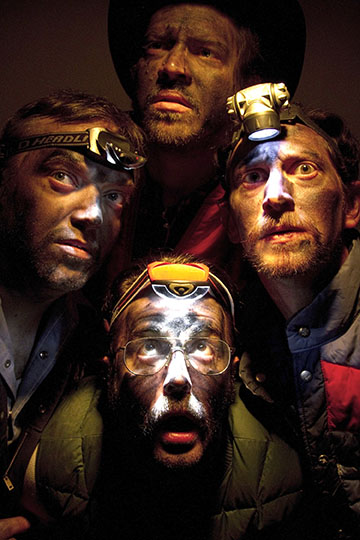 3. BUTCHER HOLLER HERE WE COME
3. BUTCHER HOLLER HERE WE COME
Written by Casey Wimpee
Aztec Economy
Directed by Leah Bonvissuto
CAST
Adam Belvo – K-Bus
Isaac Byrne – Hiccup
Michael Mason – Muskie
Adam Laten Willson – Leander
Cole Wimpee – Jet
Reviewed performance on Saturday, March 8th, 2014
Reviewed by Chris Jackson, Associate Theater Critic
for John Garcia’s THE COLUMN
Darkness and sound. This is a play about darkness and sound. In 1973, five coalminers trapped in a collapsed West Virginia mine struggle against the dark, their fears and the growing claustrophobia by using their voices. They sing, they tell stories, they joke and they make sounds, any kind of sounds to alleviate the terror that incidentally builds into the audience. In the tight confines of the Stone Cottage adjacent to WaterTower Theater, the cold, rainy afternoon outside and the dark space inside perfectly came together to add verisimilitude to the drama expertly crafted by the Aztec Economy company.
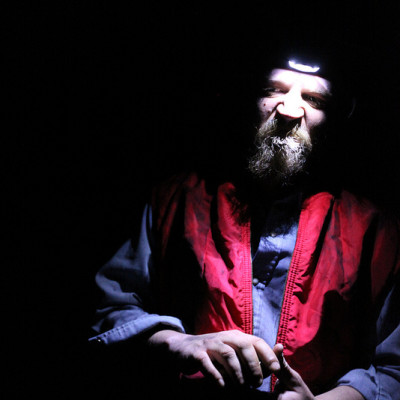 The five actors, having performed together since 2008 as members of an arts collective, work like a well-oiled machine. They play off each other’s voices with rapid fire delivery, overlapped lines and carefully orchestrated vocal dynamics, rushing words to a crescendo or fading to a slow diminuendo, all punctuated with well- crafted silences and pauses. The silence between notes and words can often be as powerful as the sound itself, and both sound and silence contribute as we begin to feel at one with these men, soon believing we are as trapped as they in the horror of a collapsed mine.
The five actors, having performed together since 2008 as members of an arts collective, work like a well-oiled machine. They play off each other’s voices with rapid fire delivery, overlapped lines and carefully orchestrated vocal dynamics, rushing words to a crescendo or fading to a slow diminuendo, all punctuated with well- crafted silences and pauses. The silence between notes and words can often be as powerful as the sound itself, and both sound and silence contribute as we begin to feel at one with these men, soon believing we are as trapped as they in the horror of a collapsed mine.
As the play progresses, we hear stories, learn about relationships, and begin to see (hear?) these men as individuals. Beginning in total darkness and then illuminated only by the light from their headlamps, the actors create a totally believable environment. Each scene is separated by moments of blackness and always, always, the sound of pounding, breathing and strange emanations from the enveloping lack of light.
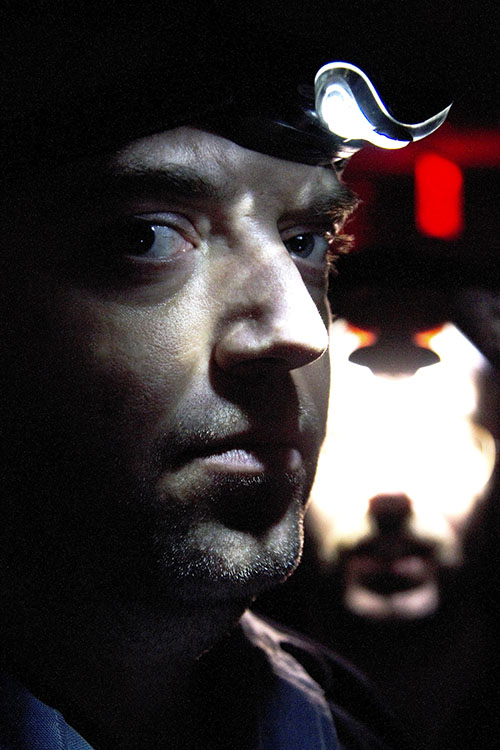 There’s talk of Brylcreem and singing of the pomade’s familiar jingle – at least familiar to those in the audience old enough to remember. They mention a case the Bible should be in that holds dynamite, tell ghost stories and talk of Lazarus. There are monologues in the darkness, some in rhyme. Together the men sing country-western songs and in a long extended moment, two of the men are threatened by a third wielding a pipe in a horrifying game that is repeated later as a game of redemption and hope.
There’s talk of Brylcreem and singing of the pomade’s familiar jingle – at least familiar to those in the audience old enough to remember. They mention a case the Bible should be in that holds dynamite, tell ghost stories and talk of Lazarus. There are monologues in the darkness, some in rhyme. Together the men sing country-western songs and in a long extended moment, two of the men are threatened by a third wielding a pipe in a horrifying game that is repeated later as a game of redemption and hope.
Almost lyrical at times, this production is gripping from the opening seconds, and the performers know well that you need to “grab ahold and keep ahold” of your audience as playwright Wimpee says in an interview. Knowing the real threat can be the psychological stuff that comes to the fore under stress, the physical danger of being trapped is less daunting then the secrets and fears that emerge from the inner darkness of the men’s minds. Each performer gets a chance to “shine” in that darkness as they tell their character’s own story and reveal aspects of each.
While the Appalachian dialects and pace may take a moment to get used to, the confined space forces you to be part of the story. Eventually you just let the experience wash over you and carry you along. The story is there to be found in the darkness and the sound.
Reviewed by Chris Jackson, Associate Theater Critic
for John Garcia’s THE COLUMN
BUTCHER HOLLER HERE WE COME
Aztec Economy
_____________________________________________________________________
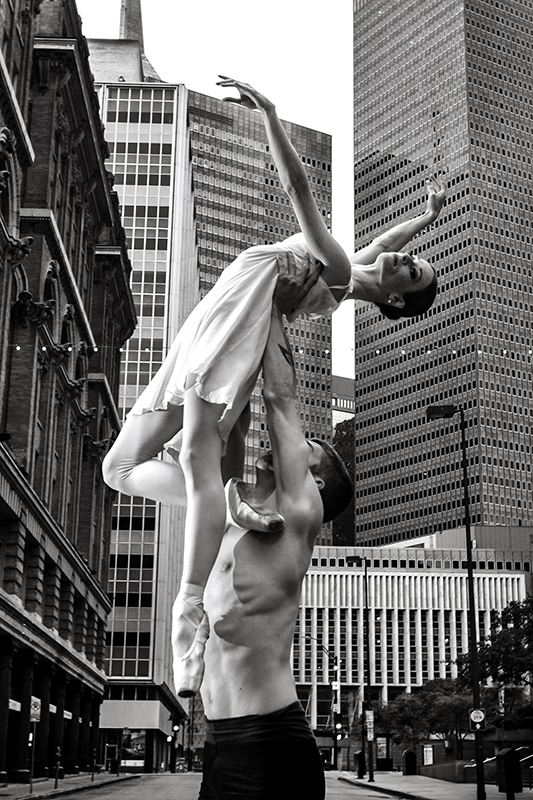 4. AN EVENING WITH DNCB
4. AN EVENING WITH DNCB
Dallas Neo-Classical Ballet
CHOREOGRAPHERS
Emilie Skinner, Jaclyn Brewer-Poole, Addison Reed, and Victoria Dolph-Tran
DANCERS
Lea Essmyer, Julie DuBois, Katie Stasse, David Sanders, Whitney Hart, Jaclyn Brewer-Poole, Mike Stone, Dorian Hejny, Emilie Skinner, Erin Boone, Victoria Dolph Tran, and Brandon McGee
Reviewed performance on Saturday, March 8th, 2014
Reviewed by Joel David Taylor, Associate Theater Critic
for John Garcia’s THE COLUMN
An Evening with DNCB (Dallas Neo-Classical Ballet) presents some well-recognized ballet pieces as well as some original works from their repertoire. It is a delight to see many of the talented dancers from Contemporary Ballet Dallas’s OOTLFF presentation, Sidewalk Stories, also performing with DNCB. This production is divided into two acts with an intermission in between.
The festival’s playbill did not include the entire performance’s pieces:
1. Carmen – with Lea Essmyer
2. Gamzatti – with Julie DuBois
3. La Deesse de la Terre – Choreography by Emilie Skinner – with Katie Stasse and David Sanders
4. Paquita – with Whitney Hart
5. The Garden – Choreography by Jaclyn Brewer Poole – with Jaclyn Brewer Poole, Mike Stone, Lea Essmyer, Whitney Hart, Julie DuBois, Dorian Hejny and Emilie Skinner
6. Fractured Night – Choreography by Addison Reed – with Lea Essmyer, Erin Boone and Katie Stasse
7. Constellations – Choreography by Victoria Dolph Tran – with Whitney Hart, Dorian Hejny and Victoria Dolph Tran
8. Black Swan – with Katie Stasse and David Sanders
9. Diana – with Brandon McGee and Jaclyn Brewer-Poole
10. Prelude – with Victoria Dolph Tran
11. Raymonda – with Katie Stasse
12. Yakhalo – Choreography by Emilie Skinner – with Lea Essmyer, Mike Stone, Jaclyn Brewer-Poole David Sanders and Whitney Hart
Using a bare stage, lighting changes include greens, blues, ambers and violets to create moods and settings, accentuate the music, and illuminate the incredible talents of the dancers. Their performances pulled me into each dance, from the first to the last. Though needed by the dancers to prepare for the second act, the intermission was a piece of time when I did not want to disconnect from what I was experiencing by the powerful presentations of each dancer on stage. While there were some minor bobbles and movements to remind me dancers are indeed mere mortals, in several dances, it seems as if no mortal could float, leap, bow and bend as they do. The dancers present a variety of stories that evoke deep emotion.
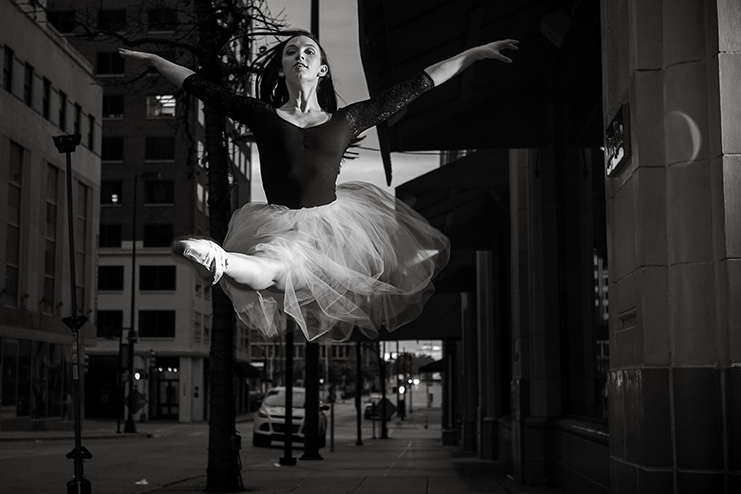 Beginning with a strong piece from Carmen that highlights the strengths of the dancer, each dance powers forward with a balance of strength and lightness. Several of the pieces are unexpectedly short, though this may be because the dancers are so compelling that time really does seem suspended while the viewer is immersed in their performances on stage. Whether the piece contains one dancer or multiple, are all well-choreographed and performed.
Beginning with a strong piece from Carmen that highlights the strengths of the dancer, each dance powers forward with a balance of strength and lightness. Several of the pieces are unexpectedly short, though this may be because the dancers are so compelling that time really does seem suspended while the viewer is immersed in their performances on stage. Whether the piece contains one dancer or multiple, are all well-choreographed and performed.
The stories are told so completely and believably, even without noticing the dance’s title. During “The Garden”, while watching the two lead dancers in flesh-colored costumes and one dancer in red, moving sinuously in the background, my thought was that this story is about Adam and Eve in the Garden of Eden.
The performance concludes on an artistically powerful note with “Yakhalo”, an original piece. Once you’ve seen this, you will understand why it is chosen for the finale in that it incorporates finesse, power and grace with perfectly timed choreography and deceptive strength of each dancer.
One of the many things I appreciate about this dance company is the dedication to the craft, and the passion for the dance that is apparent in each dancer. The standard stereotype that only tall, skinny people can be dancers is disregarded in this company. The dancers with Dallas Neo Classical Ballet are all incredibly skilled and are, well, real people, dedicated to developing and sharing their considerable talents with other real people.
Time and again, I was pulled into the world of An Evening with DNCB through the connection the dancers have with their characters and with their partner, whether two or more, when onstage together. Each individual piece is worth the cost of admission. To be able to see all of them in one session would be worth the cost of the festival pass, even if to see this production multiple times. Watching these dancers is both entertaining and inspiring.
Reviewed by Joel David Taylor, Associate Theater Critic
for John Garcia’s THE COLUMN
AN EVENING WITH DNCB
_____________________________________________________________________
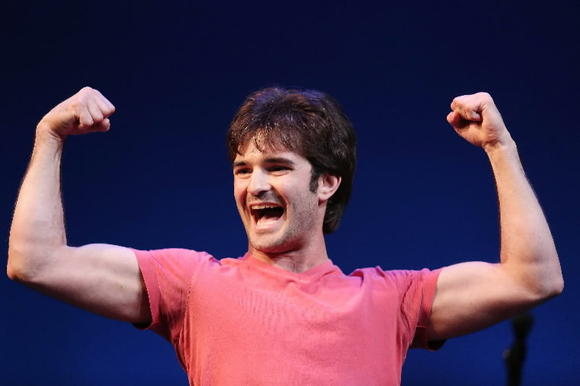 5. PLAYING WITH MYSELF – An Exercise in Narcissism
5. PLAYING WITH MYSELF – An Exercise in Narcissism
Written and Performed by Jeff Collangelo
Reviewed performance on Saturday, March 8th, 2014
Reviewed by Chris Jackson, Associate Theater Critic
for John Garcia’s THE COLUMN
A jar of pickles, a bottle of water, two chairs and a mirror. Surely a story is in that assortment somewhere! Of course later there are identical sock puppets, stuffed animals, a script, and also a befuddled sound guy dragged in for a fight. Oh, and there’s lots of talk about a possum too. All of this is part of Jeff Collangelo’s Playing With Myself (An Exercise in Narcissism). I laughed my ass off.
It’s a one-man show and, of course, one-man/woman shows CAN be an exercise in narcissism. However in this case, Jeff uses the myth of Echo and Narcissus (look it up) as a basis for the entire evening and it’s really a clever and wonderful way to talk about actors and acting and how we see ourselves and how we perceive what we see reflected back to us in other people. There’s also discussion of sleeping and dreaming and nightmares and waking up …or not. Reality? Unreality?
It’s a fully scripted evening, not improvised, and begins by having the audience do a “call and response” with Mr. Collangelo, echoing what we have been instructed to do. Not only does the audience get warmed up, but they get sucked into the whole Echo/Narcissus thing immediately. A large mirror – really a large piece of reflective metal – is on the stage floor from the top of the show and becomes the pool in which Narcissus sees his own reflection and later an actual mirror used by the performer to make his point about his own personality, and ours by extension.
At times using recorded sound, the evening goes from wild hilarity with the story of the theater teacher’s reaction to a possum to more serious insights also cloaked in humor. Mr. Collangelo is a talented performer whose background in combat training and movement are brilliantly and constantly on conscious or unconscious display.
There is talk of Shakespearean acting styles and a whole “To be or not to be” recitation of Hamlet’s famous soliloquy that you won’t soon forget, first for its hilarity and then for its beauty. Another segment, which speaks of spirit animals, eventually brings up the possum and some of the funniest parts of the evening.
In the spirit of narcissism, the show is very much about actors and how they only exist fully when there’s an audience to perform for and how they feed off the reflection of those reactions, verbal, audible or only subliminal. It is also, of course, about how we perceive ourselves, the validity of that perception and how we sometimes fight what we perceive. Can we trust the echo, the reflection? Is it only giving us what we put forth or are we too busy being concerned about that to truly live? Should we just play possum?
Playing With Myself is a one hour show presented with enormous humor and skill. Mr. Collangelo allows us to see his and our own vulnerability with just enough bravado to make a thoroughly entertaining and perceptive evening. Oh, and that jar of pickles pays off too!
Reviewed by Chris Jackson, Associate Theater Critic
for John Garcia’s THE COLUMN
PLAYING WITH MYSELF – An Exercise in Narcissism
____________________________________________________________________
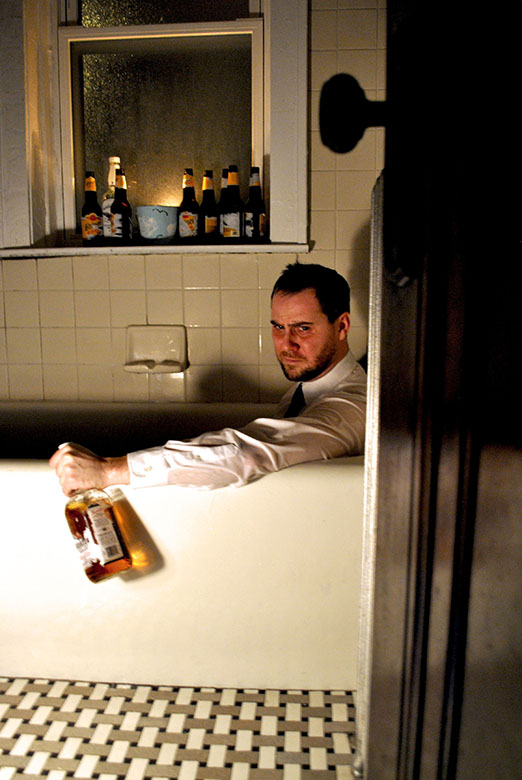 6. SWEET CHARIOT
6. SWEET CHARIOT
Written by Cody Lucas
Sundown Collaborative Theatre
Directed by Cody Lucas and Tashina Richardson
Set and Properties Design – Irvin A. Moreno
Lighting Design – Natalie Taylor
CAST
Billy Baraw – John
Morgan Hillan – Boyd Worley
Reviewed performance on Sunday, March 9th, 2014
Reviewed by Richard Blake, Associate Theater Critic
for John Garcia’s THE COLUMN
How did he get there? John sits in his bathtub getting drunk, seeking philosophical answers and emotional comfort from Boyd Worley's midnight radio show. Time and reality blur as Sweet Chariot explores the emotional psyche of a man in crisis.
One word.... captivating!
For fifty-five minutes you hang on every word uttered onstage by the supremely talented Billy Barlow as John, supported in a voiceover presentation of Boyd Worley, the radio host, played by Morgan Hillan. The two men take you on a philosophical journey about life and one man’s struggles with it in such a powerful way, you leave speechless.
Mr. Barlow is the epitome of excellence in acting. You never know if you’re watching him play a man spiraling out of control into psychosis or a man taking that same spiral into self-awareness and clarity. The performance is beautiful and you’re completely engaged throughout the piece. One of the most powerful things an actor can do is... nothing. Not say anything, but engage the audience in silence simply with physical action and facial expression. Mr. Barlow shows this skill like no other with his expertise and passion. You wait for every word, or lack thereof, with complete engagement and anticipation.
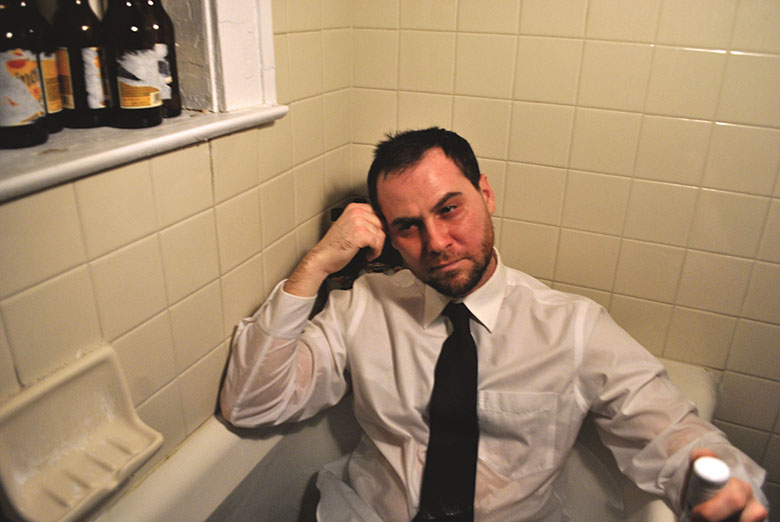 By the way, Mr. Barlow does all of this magnificent acting while sitting in a bathtub full of water. Yes, and the water becomes somewhat of a player in the story as well. Watching him sitting in a bathtub full of water, fully dressed is unnerving, yet at the same time intriguing. It’s a wonderfully unique approach to theatre and definitely a presentational success!
By the way, Mr. Barlow does all of this magnificent acting while sitting in a bathtub full of water. Yes, and the water becomes somewhat of a player in the story as well. Watching him sitting in a bathtub full of water, fully dressed is unnerving, yet at the same time intriguing. It’s a wonderfully unique approach to theatre and definitely a presentational success!
High praise must also go to Morgan Hillan in his unseen role. His vocal inflections as the radio host are perfectly delivered, and when he’s interacting with his “listener” he shines even more. Creating emotion and holding an audience with only your voice can be quite difficult and takes a lot of rehearsal and talent. It is obvious this unseen actor has both and he added a wonderfully impressive live element to the production.
The script is well written, detailed and highly imaginative. There are wonderful, highly-detailed sections of the main character’s emotion breakdowns which flow beautifully into simplistic exchanges of humor. The ending is striking as its written and will definitely leave you asking questions.
This is one Out of the Loop presentation you do not want to overlook during the festival!
Reviewed by Richard Blake, Associate Theater Critic
for John Garcia’s THE COLUMN
SWEET CHARIOT
Sundown Collaborative Theatre



